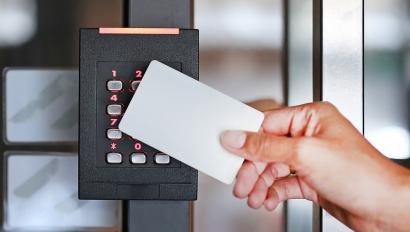The 4 Most Common Types of Access Control Credentials

4 Types of Access Control Credentials
Modern electronic access control systems, whether on-premise or cloud-hosted, offer a variety of ways to authenticate users and grant them access to a space. Credentials are typically classified into a few categories, something you have, something you know, something you are, or any combination of these categories (multi-factor).
Keep reading to learn about four of the most common types of access control credentials and how they can help you manage your space more effectively.
1. RFID access control
Historically, the most common credential is RFID technology using some sort of card or fob (something you have). These RFID options can range from basic proximity cards and fobs to more advanced and secure smart cards that use integrated circuit chips embedded into the card itself to provide encrypted communication with the access control readers. Not all access control cards are secure as some can be easily sniffed and cloned. Access control cards can also easily be lost or stolen, which can create a vulnerability.
2. PIN Codes access control
PIN codes are also a popular method where a PIN code (something you know) is assigned to a user and then used as their credential to access a space. With PIN codes, a user walks up to the keypad on a door and types in a numerical code assigned to them to authenticate and gain access to a space. PIN codes do have some drawbacks as well. PIN codes are often shared, creating a security risk. In addition, PIN codes can be cumbersome to administer and maintain.
3. Biometric access
Biometric credentials have grown in popularity over the past several years and can include multiple biometric features (something you are). There are biometric devices that can scan fingerprints, retinas, or the palms of your hand to authenticate you and grant or deny access. Another biometric option is facial scanning where a device can scan a face to determine facial features that can be turned into a hash that can then be used as a credential. Biometric readers have come a long way and can offer a high level of security, but in order for biometric readers to work effectively and efficiently, they need to be installed in the right location and in the right environmental conditions.
4. Mobile Credentials access control
Perhaps one of the fastest-growing credentials lately is mobile credentials. Mobile credentials allow users to have a credential stored on their mobile devices, usually in the form of a mobile app, that they can use to gain access to spaces providing those spaces have compatible hardware. As a user approaches a reader, they can make an unlock request using a button on their phone or even a gesture, to gain access. Mobile credentials also have the advantage of providing multi-factor authentication easily by leveraging the built-in PIN code functionality or biometric readers of the mobile device for additional security. A system administrator can require that in addition to the mobile credential a user needs to provide either a PIN code and/or a fingerprint/facial recognition, whichever method the mobile device supports. Mobile credentials have grown in popularity so much because just about everyone has a mobile device with them at all times, and they are easy to administer compared to managing RFID cards or PIN codes.
Still not sure which access control credential solution is right for you? We’re here to help.
The goal is no longer just limiting access to a particular space but rather managing that space effectively.
Modern electronic access control systems offer a wide variety of features to allow you to better manage business spaces and to protect your business and your brand.
Working with a qualified security sales consultant will ensure you are not installing old technology into a new installation. There is an access control solution available that is convenient, secure, and works for your user’s technology level.
---
Disclaimer: By using the Blog section of this website (“Blog”), you agree to the terms of this Disclaimer, including but not limited to our terms of use and our privacy policy. The information provided on this Blog is for informational purposes only. Such information is not intended to provide advice on your specific security needs nor to provide legal advice. If you would like to speak to a security representative about your specific security needs, please contact us.























